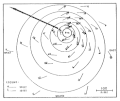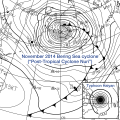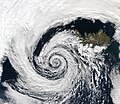The Tropical Cyclones Portal
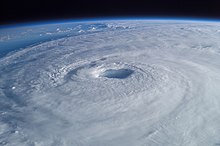
A tropical cyclone is a storm system characterized by a large low-pressure center, a closed low-level circulation and a spiral arrangement of numerous thunderstorms that produce strong winds and heavy rainfall. Tropical cyclones feed on the heat released when moist air rises, resulting in condensation of water vapor contained in the moist air. They are fueled by a different heat mechanism than other cyclonic windstorms such as Nor'easters, European windstorms and polar lows, leading to their classification as "warm core" storm systems. Most tropical cyclones originate in the doldrums, approximately ten degrees from the Equator.
The term "tropical" refers to both the geographic origin of these systems, which form almost exclusively in tropical regions of the globe, as well as to their formation in maritime tropical air masses. The term "cyclone" refers to such storms' cyclonic nature, with anticlockwise rotation in the Northern Hemisphere and clockwise rotation in the Southern Hemisphere. Depending on its location and intensity, a tropical cyclone may be referred to by names such as "hurricane", "typhoon", "tropical storm", "cyclonic storm", "tropical depression" or simply "cyclone".
Types of cyclone: 1. A "Typhoon" is a tropical cyclone located in the North-west Pacific Ocean which has the most cyclonic activity and storms occur year-round. 2. A "Hurricane" is also a tropical cyclone located at the North Atlantic Ocean or North-east Pacific Ocean which have an average storm activity and storms typically form between May 15 and November 30. 3. A "Cyclone" is a tropical cyclone that occurs in the South Pacific and Indian Oceans.
Selected named cyclone -
Very Severe Cyclonic Storm Yaas (Arabic pronunciation: [jaʔas]) was a relatively strong and very damaging tropical cyclone that made landfall in Odisha and brought significant impacts to West Bengal during late May 2021. The second cyclonic storm, second severe cyclonic storm, and second very severe cyclonic storm of the 2021 North Indian Ocean cyclone season, Yaas formed from a tropical disturbance that the Indian Meteorological Department first monitored on May 23. Conditions in the basin favored development as the system became a deep depression later that day, before intensifying into a cyclonic storm on the next day, receiving the name Yaas. The system further intensified as it turned to the northeast, becoming a severe cyclonic storm on May 24 despite moderate wind shear. Marginally favorable conditions further continued as Yaas accelerated northeastward, strengthening to a Category 1-equivalent tropical cyclone and to a very severe cyclonic storm on May 25. Yaas crossed the northern Odisha coast around 20 km south of Balasore at its peak intensity as a very severe cyclonic storm on May 26. Upon landfall, the JTWC and IMD issued their final advisories as Yaas further weakened inland while turning north-northwestwards.
In preparations for the storm, many electrical companies in West Bengal and Odisha prepared additional generators and transformers for possible electrical problems. Evacuations were also ordered, starting on May 24 on low-lying areas in East Midnapore and West Midnapore and Jhargram. Hooghly, Kolkata and North 24 Parganas and South 24 Parganas are now placed on high alert. Railway operations and marine activities were halted due to Yaas, while rescue authorities and medical teams were deployed in for possible emergencies. In Bangladesh, over two million individuals were ordered to be evacuated in coastal areas of the country due to the storm's approach. Food supplies and emergency funds were also released for the evacuees. 20 people across India and Bangladesh died due to Yaas. West Bengal was the hardest hit Indian state, with an estimated loss of ₹210 billion (US$2.89 billion). Odisha also suffered a loss of ₹6.1 billion (US$83.9 million). (Full article...)
Selected article -
The effects of Typhoon Bopha in the Caroline Islands were significant, though limited in extent in comparison to the cyclone's intensity. Typhoon Bopha originated from a tropical depression south of Pohnpei on November 25, 2012, and tracked generally westward for more than a week. During this time, it threatened several islands across Micronesia, prompting the issuance of typhoon watches and warnings. The system skirted the Nomoi Islands on November 28 where it caused limited damage. Thereafter, it became a threat to Palau as an intense typhoon. Residents there boarded up their homes and some evacuated to public shelters while officials enacted a strict curfew during the typhoon's passage. Bopha passed 55 km (34 mi) south of Angaur island, or 100 km (62 mi) south of Babeldaob, on December 2 with winds of 185 km/h (115 mph).
Damage was most severe in the states of Angaur, Melekeok, Ngiwal, and Ngaraard where storm surge damaged or destroyed many homes. Electricity and water service in many areas was lost during the storm, and remained so for over a week in the hardest hit areas. Throughout Palau, 92 homes were destroyed while 59 others sustained severe damage. Total damage amounted to US$10.1 million with repair costs estimated at US$15–20 million. A state of emergency was declared on December 5 while the Palau Red Cross Society assisted with recovery efforts. Palau's congress allocated US$10 million for relief while international donors provided a collective US$235,000 in aid. (Full article...)
Selected image -

Selected season -

The 2017 Pacific hurricane season was an above average Pacific hurricane season in terms of named storms, though less active than the previous three, featuring eighteen named storms, nine hurricanes, and four major hurricanes. Despite the considerable amount of activity, most of the storms were weak and short-lived. The season officially started on May 15 in the eastern Pacific Ocean, and on June 1 in the central Pacific; they both ended on November 30. These dates conventionally delimit the period of each year when most tropical cyclones form in the respective regions. However, the formation of tropical cyclones is possible at any time of the year, as illustrated in 2017 by the formation of the season's first named storm, Tropical Storm Adrian, on May 9. At the time, this was the earliest formation of a tropical storm on record in the eastern Pacific basin proper (east of 140°W). The season saw near-average activity in terms of accumulated cyclone energy (ACE), in stark contrast to the extremely active seasons in 2014, 2015, and 2016; and for the first time since 2012, no tropical cyclones formed in the Central Pacific basin. However, for the third year in a row, the season featured above-average activity in July, with the ACE value being the fifth highest for the month. Damage across the basin reached $375.28 million (2017 USD), while 45 people were killed by the various storms.
Prior to the start of this season, the National Hurricane Center (NHC) changed its policy to permit issuance of advisories on disturbances that were not yet tropical cyclones but had a high chance to become one, and were expected to bring tropical storm or hurricane conditions to landmasses within 48 hours. As a result of this change, watches and warnings could be issued by local authorities. Such systems would be termed as "Potential Tropical Cyclones". The first system to receive this designation was Potential Tropical Cyclone Fourteen-E, which developed into Tropical Storm Lidia south-southeast of the Baja California Peninsula on August 30.
(Full article...)Related portals
Currently active tropical cyclones

Italicized basins are unofficial.
- North Atlantic (2024)
- No active systems
- East and Central Pacific (2024)
- No active systems
- North Indian Ocean (2024)
- No active systems
- Mediterranean (2024–25)
- No active systems
- Australian region (2024–25)
- No active systems
- South Pacific (2024–25)
- No active systems
- South Atlantic (2024–25)
- No active systems
Last updated: 09:03, 18 November 2024 (UTC)
Tropical cyclone anniversaries

November 20
- 1985 - Hurricane Kate (pictured) reached Category 3 strength in the eastern Gulf of Mexico. It made landfall in Florida the next day.
- 1992 - Cyclone Forrest reaches its maximum intensity as a Category 4 over in the Bay of Bengal, before re-curving and making landfall in Myanmar.
- 1994 - Cyclone 02A makes landfall over in Somalia, killing 30 people in total.

November 21
- 1992 - Typhoon Gay (pictured) reached its peak intensity with winds of 300 km/h (185 mph) in the open Pacific Ocean.
- 2015 - Typhoon In-fa reaches its peak strength as a Category 4 with 1-minute sustained winds of 220 km/h (140 mph) and a minimum pressure of 935 hPa.

November 22
- 1981 - Typhoon Irma (pictured) reached its peak intensity with winds of 250 km/h (155 mph) in the Philippine Sea as it approached its landfall in the northern Philippines. Irma caused over 200 deaths on Luzon.
- 2004 - Cyclone Bento rapidly intensifies into an intense Category 5 cyclone with 1-minute sustained winds of 260 km/h (160 mph) along with a pressure of 915 hPa, out in the Indian Ocean.
Did you know…
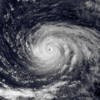



- …that the Joint Typhoon Warning Center considers that Typhoon Vera (pictured) of 1986 is actually two distinct systems, formed from two separated low-level circulations?
- …that Cyclone Freddy (track pictured) in 2023 was the longest-lasting tropical cyclone worldwide?
- …that Cyclone Raquel (track pictured) travelled between the Australian and South Pacific basins between the 2014–15 and 2015–16 seasons, spanning both seasons in both basins?
- …that Hurricane Otis (pictured) in 2023 was the first Pacific hurricane to make landfall at Category 5 intensity and surpassed Hurricane Patricia as the strongest landfalling Pacific hurricane on record?
General images -

The 2003–04 South Pacific cyclone season was a below-average season with only three tropical cyclones occurring within the South Pacific to the east of 160°E. The season officially ran from November 1, 2003, to April 30, 2004, with the first disturbance of the season forming on December 4 and the last disturbance dissipating on April 23. This is the period of the year when most tropical cyclones form within the South Pacific Ocean.
During the season at least 16 deaths resulted from tropical disturbances whilst overall damage was estimated at $218 million (2004 USD; $352 million 2024 USD). The most damaging tropical disturbance was Cyclone Heta which caused at least $211 million (2004 USD; $340 million 2024 USD) in damage to six different countries and left three dead. The deadliest tropical disturbance of the season was Tropical Depression 10F, which was responsible for eleven deaths and caused $2.74 million (2004 USD; $4.42 million 2024 USD) in damage. Cyclone Ivy also caused 2 deaths and caused $4.17 million (2004 USD; $6.73 million 2024 USD) worth of damage to Vanuatu. As a result of the impacts caused by Heta and Ivy, the names were retired from the tropical cyclone naming lists. (Full article...)
Topics
Subcategories
Related WikiProjects
WikiProject Tropical cyclones is the central point of coordination for Wikipedia's coverage of tropical cyclones. Feel free to help!
WikiProject Weather is the main center point of coordination for Wikipedia's coverage of meteorology in general, and the parent project of WikiProject Tropical cyclones. Three other branches of WikiProject Weather in particular share significant overlaps with WikiProject Tropical cyclones:
- The Non-tropical storms task force coordinates most of Wikipedia's coverage on extratropical cyclones, which tropical cyclones often transition into near the end of their lifespan.
- The Floods task force takes on the scope of flooding events all over the world, with rainfall from tropical cyclones a significant factor in many of them.
- WikiProject Severe weather documents the effects of extreme weather such as tornadoes, which landfalling tropical cyclones can produce.
Things you can do
 |
Here are some tasks awaiting attention:
|
Wikimedia
The following Wikimedia Foundation sister projects provide more on this subject:
-
Commons
Free media repository -
Wikibooks
Free textbooks and manuals -
Wikidata
Free knowledge base -
Wikinews
Free-content news -
Wikiquote
Collection of quotations -
Wikisource
Free-content library -
Wikiversity
Free learning tools -
Wikivoyage
Free travel guide -
Wiktionary
Dictionary and thesaurus












